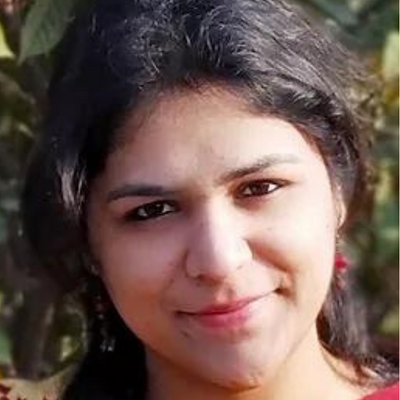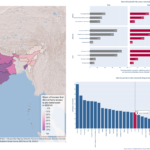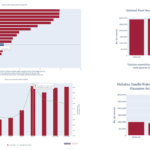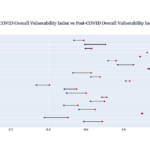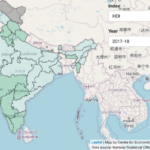Assembly Elections 2023: Access to basic housing infrastructure in the five states
An analysis of data from the NSS (Round 78) to understand housing conditions of different groups in Chhattisgarh, Madhya Pradesh, Mizoram, Rajasthan and Telangana as they head into assembly polls.
Key highlights
- As of 2020-21, the five states had made unequal progress on improving access to basic facilities and housing infrastructure
- Nearly half of all households in Telangana were living in houses with basic housing infrastructure such as separate toilets, kitchens and bathrooms, the highest among these five states
- In Chhattisgarh and Madhya Pradesh, a majority of households still relied on hand pumps and tube well as the primary source of drinking water in 2020-21
- In three states – Chhattisgarh, Madhya Pradesh and Rajasthan – more than half of all households still relied on solid unclean fuels for cooking
A new season of state elections is currently underway since November 7, with five states – Chhattisgarh, Madhya Pradesh, Mizoram, Rajasthan and Telangana – voting for their new Assemblies over a three-week period (Nov 07-30). The five states form an eclectic and diverse mix of socio-economic contexts and political histories.
In the first part in this series, we explored data from different rounds of the Periodic Labour Force Survey to understand the labour force and employment situation in each of these states in greater depth.
In this part, we look at the living conditions of people in each of the five states – what kind of houses they live in, what is the primary source of drinking water, how many lived in households with separate spaces for cooking and bathing, as well as access to basic infrastructure such as all-weather roads, hospitals for emergency care and arrangements for garbage disposal.
The following analysis is based on data from the Multiple Indicator Survey (NSS Round 78) released earlier this year. The data is based on a household survey from 2020-21. We look at patterns for each state and how they vary for rural and urban households, as well as households from different social groups. Note: The sample size for Mizoram is not large enough to permit disaggregation by social group, so that analysis is only for the other four states.
The share of households living in houses with basic infrastructure (such as separate bathrooms and kitchens) remains lower than the national average in all states except Telangana
In an earlier Data Narrative, CEDA had noted that while eighty five percent of households in India were living in a “pucca” house in 2020-21, a much smaller share (28.4 percent) were living in pucca houses that had a separate kitchen, a toilet and a bathroom for exclusive use, and had some form of arrangement for disposing of household garbage. While 60.6 percent of urban houses satisfied these criteria, in rural areas this share was as low as 13.3 percent.
In this section, we examine the same for the five states that are currently in the middle of their assembly elections. For the sake of brevity, we call these criteria “basic housing”.
Figure 1
| State | ST | SC | OBC | Others | Total |
|---|---|---|---|---|---|
| Rajasthan | 6.5 | 19.7 | 24.1 | 47.4 | 24.3 |
| Chhattisgarh | 4.7 | 13.9 | 27.2 | 56.6 | 19.3 |
| Madhya Pradesh | 3.3 | 12.6 | 17.8 | 40.8 | 17.7 |
| Telangana | 24.2 | 33.1 | 50.7 | 76.7 | 48.8 |
| India | 10.0 | 17.4 | 30.6 | 40.5 | 28.4 |
** Defined here as pucca houses with a separate kitchen, a bathroom and toilet for the exclusive use of the household, and some arrangement for garbage disposal
Source: Multiple Indicator Survey (NSS Round 78), 2020-21
Nearly half of all households in Telangana were living in houses with all the above criteria. In urban parts of the state, the share was 71.3 percent, while in rural parts it was 32 percent. Less than a quarter of households belonging to Scheduled Tribe (ST) communities and only a third of households belonging to Scheduled Caste communities (SC) were living in such basic housing in the state, while among those from dominant caste communities, the share was 76.7 percent.
In Rajasthan, nearly a quarter (24.3 percent) of houses fulfilled similar criteria in 2020-21, with this share varying between 11.5 percent for rural houses and 62.9 percent for urban ones. Only 6.5 percent of households belonging to Scheduled Tribe communities lived in pucca homes with this basic infrastructure, while among dominant caste communities, the share was 47.4 percent.
In Chhattisgarh, less than a fifth of all households were living with basic housing in 2020-21. There was a very wide rural-urban gap and only 5.7 percent of rural households fulfilled these criteria, while in urban areas the corresponding share was 62.6 percent.
In Mizoram, the share of households with adequate housing was only 18.5 percent with 15.9 percent rural households and 21.4 percent urban households fulfilling the criteria.
And in Madhya Pradesh, only 17.7 percent of households were living in pucca houses with separate kitchens, a toilet, bathroom and some arrangement for disposing of household waste. But this was true for only 3.7 percent of rural households in the state as compared to 55.9 percent of urban ones.
Chhattisgarh and Madhya Pradesh trail when it comes to piped water being the primary source of drinking water for households, Telangana leads in reliance on bottled water
Piped water was the primary source of drinking water for over two-thirds of households in Mizoram and Telangana in 2020-21. In Rajasthan, this share was 48.6 percent. The three states did better than the national average – in the same period, 36.6 percent of households across India had piped water as the primary source of drinking water. On the other hand, in Chhattisgarh and MP, 24.6 percent and 29.6 percent of households reported piped water to be their primary source of drinking water (Figure 2).
In all states, a significantly smaller share of rural households reported piped water as their primary source of drinking water as compared to their urban counterparts (Figure 2), with rural ST households the least likely to have access to piped water among all social groups.
In both Chhattisgarh and Madhya Pradesh, more than half (57.2 percent and 53 percent respectively) the households relied on tube wells and hand pumps for drinking water, with this share being higher in rural parts of the states (67.4 percent and 64.2 percent of the rural households respectively in the two states drew their drinking water primarily from this source). In contrast, in Mizoram, no households relied on tube wells and hand pumps.
Strikingly, nearly a fifth of households (19.9 percent) in Telangana reported depending on bottled water as the primary source of drinking water. This is much higher than the national average – 5.6 percent of households across India reported bottled water as the primary source of drinking water in 2020-21 (with this share being 3.7 percent in rural areas and 8.9 percent in urban areas). In Telangana, a similar proportion of urban and rural households depended on bottled water. Among the other four states, the share of households that relied on bottled water was negligible (less than 1 percent).
Telangana has achieved near-universal access to clean cooking fuel; all other states still have much ground to cover
As CEDA has previously noted, across India, only 59 percent of houses had a separate kitchen as of 2020-21. Only Chhattisgarh does better than the national average – 65.1 percent of households in the state lived in a house with a separate kitchen in 2020-21. In Rajasthan and Telangana, the corresponding shares were 59.6 percent and 56.1 percent respectively, while in Madhya Pradesh and Mizoram, only 39.4 percent and 20.9 percent of households respectively had separate kitchens.
However, when it comes to access to clean fuel, it is Telangana that fares the best. In 2020-21, 96.9 percent of all households had access to clean fuel in the state, and this share was 95.5 percent among rural households and 98.7 percent among urban ones. Access to clean fuel remained high across socio-economic groups in the state (Figure 3).
On the other hand, only 30.9 percent of Chhattisgarh’s households had access to clean cooking fuel – among rural households, the share was a meagre 15.2 percent. This access varied greatly by socio-economic group. While less than a tenth (7.9 percent) of rural ST households had access to clean fuel in the state in 2020-21, among urban dominant caste households, the corresponding share was 91.4 percent.
As a result, a high share of households in Chhattisgarh (68.9 percent), Madhya Pradesh (58.4 percent) and Rajasthan (55.1 percent) continued to depend on solid fuels (such as firewood, chips & crop residue, dung cake, kerosene, coke, coal charcoal) for cooking in 2020-21. In rural parts of these states, the share of households using solid fuels was even higher (from 70.2 percent in Rajasthan to 75.7 percent in Madhya Pradesh and 84.7 percent in Chhattisgarh).
Mizoram had achieved near-universal access to toilets in 2020-21, while Madhya Pradesh and Rajasthan’s progress was slower than the national average
Even as access to toilets has been receiving policy priority in recent years, barring Mizoram, none of the other states had reached the stage where all (or nearly all) households had access to a toilet for the exclusive use of the household. Madhya Pradesh lagged behind the rest with only two-thirds of households reporting such access – and this share varied between 60.9 percent in rural areas and 80.5 percent in urban areas.
In Mizoram, nearly all (97.7 percent) houses had a separate space dedicated as a bathing area for the exclusive use of the household. In Telangana, the corresponding share was 91.2 percent. Both states do much better than the national level – in 2020-21, only 63.3 percent of all households in the country had a separate bathroom in their houses. In Chhattisgarh, only 41.4 percent of households had access to this basic infrastructure, the lowest among the five states.
In all states, ST households lagged behind other social groups when it came to having a toilet or bathroom in the house. This gap was even more pronounced among ST households in rural parts of the states (Figure 5).
Mizoram and Telangana fare relatively the best on other basic infrastructure, while the other three states’ progress has been uneven
More than 90 percent of all households in Telangana had some arrangement (either institutional or at the household level) to dispose of garbage. This was the case for 85.1 percent of rural households and 97.4 percent of urban households in the state. In Mizoram, the share of households with arrangements to dispose of garbage was 88.8 percent. In Rajasthan and Madhya Pradesh, only 37.1 and 37.8 percent of households respectively had a garbage disposal arrangement, with less than a fifth of rural households having such an arrangement in both states.
Across India, 44.9 percent of households (with this share varying between 24.7 percent for rural areas and 87.9 percent for urban areas) had a hospital within a 5km distance where they could access emergency care if needed. In Mizoram, this share was 53 percent, the highest among the five states in focus, followed by Telangana (49.8 percent), Rajasthan (38 percent), Madhya Pradesh (34.4 percent) and Chhattisgarh (32.2 percent). Across all states, there is a wide gap in access to emergency care between rural and urban areas.
Across India, 5.6 percent rural households were situated more than 2 km away from an all-weather road in 2020-21. In Mizoram, this was true only for 3.3 percent of rural households, the best among the five states, while in Chhattisgarh, 16.2 percent rural households were situated more than 2 km away from an all-weather road.
This is the second and final part in this series. The first part examining labour force participation rates in the five states is available here.
If you wish to republish this article or use an extract or chart, please read CEDA’s republishing guidelines.


